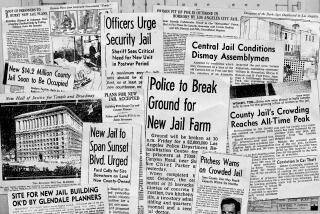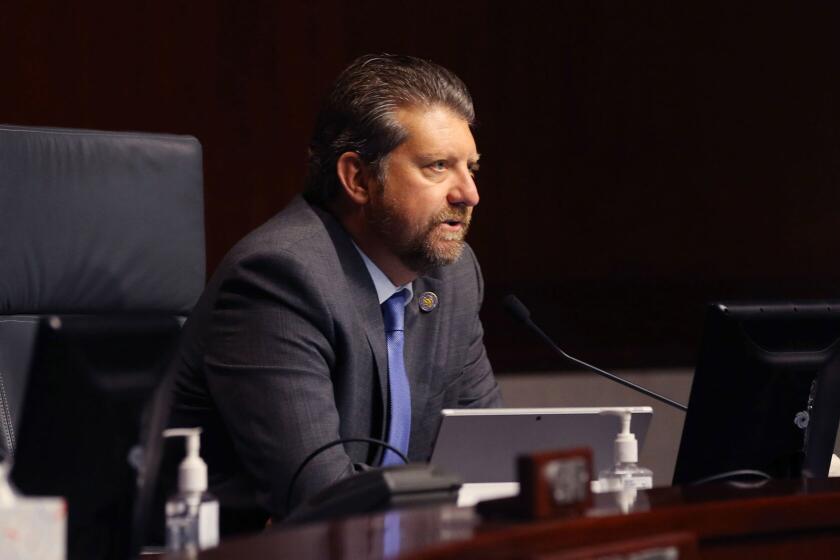Governor Signs Bill but Prisons May Be Far Off
- Share via
SACRAMENTO — Ending one of his toughest political battles, Gov. George Deukmejian announced Saturday he had signed legislation that for the first time authorizes construction of state prisons in Los Angeles County. But Administration allies and the governor’s critics agreed it may be years before the prisons are built--if they are built at all.
Environmental challenges, financial problems and other roadblocks threaten to undo a delicate legislative compromise, struck after five years of debate and aimed at giving “equal pain” to Los Angeles’ heavily Democratic Eastside and a Republican district west of Lancaster, where the prisons are to be located.
Nonetheless, the Republican governor marked the bill signing with a tough-talking radio speech in which he expressed pleasure that Los Angeles County, which contributes 38% of felons to a dangerously overcrowded prison system, is finally living up to its responsibility. And he boasted that “with this legislation we are putting criminals on notice.”
No Alternatives
“Some people may be talking about alternatives to prison, early releases and more lenient sentences,” Deukmejian said. “But here in California, we’re not listening. If you commit a serious crime, you’re going to prison.”
Senate President Pro Tem David A. Roberti (D-Los Angeles) noted, however, that despite the governor’s tough rhetoric, “the issue is not ended.”
Roberti, who has taken a good deal of political heat in opposing the Eastside prison, noted that the prison legislation “was written to give safeguards to both the citizens of East Los Angeles and Lancaster. If adverse impacts are found on either of the sites, we may have to (reconsider) the entire siting issue.”
All sides agree that the major accomplishment of the legislation is that it allows the state to open two new prisons in San Diego and near Stockton that by law have remained empty pending resolution of the Los Angeles prison dispute. Department of Corrections officials said they expect to begin moving convicts in beginning July 27 and both prisons could be operating at full capacity by year’s end.
Space for 10,000
Two other prisons in the rural communities of Avenal in the Central Valley and Ione in the Gold Country are expected to be completely occupied by that time as well. Together, the four will provide room for nearly 10,000 additional inmates.
Even so, the prison system will continue to be severly overcrowded. Designed to house fewer than 37,000 prisoners, California’s 12 prisons today hold nearly 65,000 inmates. At the rate felons continue to flow into the system--averaging more than 200 per week in recent months--experts say there may be as many as 100,000 inmates by the end of the decade.
Jeff Thompson, chief lobbyist for the California Correctional Peace Officers Assn., said Deukmejian’s signature on the Los Angeles prison bill “will provide a lot of relief” to correctional officers who are being assaulted in overcrowded prisons at what he called an alarming rate.
But Thompson, like others, said he holds no illusions that it will resolve the problems facing the prison system. “The Titanic remains afloat,” Thompson said. “We’re glad the Legislature finally bit the bullet and did its duty that it should have done a year ago. For a little while at least, we’ll have our heads above water.”
Money remains a major problem. Nearly all the funds allocated for the governor’s prison expansion program--the most ambitious in the state’s history--have been spent or are committed.
Bond Issue Funds
The $149 million estimated cost of the Eastside prison, to be built on a 20-acre parcel in an industrial area southeast of Olympic Boulevard and Santa Fe Avenue, will be paid with money from recent voter-approved bond issues.
However, there was no money allocated for the northern county prison, to be located adjacent the Mira Loma jail on the western outskirts of Lancaster. That project is expected to cost $147 million and will have to be paid for with proceeds from an $850-million bond issue that the Legislature hopes to place before voters next year.
Should that bond issue fail, both prisons could be imperiled because the legislation signed by the governor prevents either prison from opening until the other is under construction.
Department of Corrections officials also predict that the cost of operating the prison system could double to nearly $2 billion yearly when all the projects are completed.
Deukmejian, in his radio address, set the stage for the political battle ahead by arguing that “Prisons are expensive, and supporting them carries a high and unfortunate price tag. But the alternative is to turn dangerous criminals loose on our families and neighborhoods, and in my book, that’s no alternative at all.”
Approval Seen Likely
Sen. Robert Presley (D-Riverside), who has carried prison legislation for the governor, including the Los Angeles prison bill, noted, however, that voters have never rejected a prison bond.
A more immediate threat to the construction of a Los Angeles prison comes from required environmental studies and the lawsuits that are all but certain to follow.
The studies on each prison will take a minimum of a year. Deukmejian had hoped to cut short legal challenges with a provision in the bill that would allow his Administration to appeal cases directly to the Supreme Court, which is dominated by the governor’s appointees.
However, Democrats in the Legislature succeeded in stripping that provision from the bill. As a result, construction could be held up for months or years while lawsuits make their way through the state’s legal system.
On Friday, Los Angeles City Councilwoman Gloria Molina, who formerly represented the Eastside in the Assembly, launched the first legal salvo when she introduced a motion ordering the city attorney to investigate ways of blocking the Eastside prison. The City Council is expected to consider the motion Tuesday.
Source of Irritation
A major irritant to Eastside activists is the fact that the prison legislation requires no environmental review of the Eastside site until after the land is purchased. By contrast, the review on the Lancaster site would take place before the state has committed any money to the project.
Frank Villalobos, a member of the Eastside coalition fighting the prison, said the result is that “East Los Angeles, even in the law, is being treated as a different country. That is the most important thing to us.”
Lancaster residents also have threatened to file suit against the siting of a prison in their community and are armed with studies showing their site is in a flood plain and would destroy plans for residential development in the surrounding area.
For now, both sides are pinning their hopes on a hastily drafted compromise under which Deukmejian agreed to consider a third site, in the sparsely populated high desert area of Hungry Valley, north of Gorman.
There is disagreement over the exact provisions of the compromise, which could not take effect at all unless the Legislature passes a separate bill before the end of the session. If passed, however, it would allow but not require the governor to scrap one or both of the other prison sites and substitute Hungry Valley.
Not Going to Give
But on Friday, Deukmejian made it clear he does not intend to give up on at least the Eastside location. As he left a University of California regents meeting in Westwood, Deukmejian conceded that “I wouldn’t be surprised if there are legal challenges.” But the governor strongly reiterated his belief that the Eastside is the “best possible site for a prison in Los Angeles.”
Deukmejian’s reluctance to consider other proposals could cost him support of Republicans as well as Democrats.
Republican Sen. Newton Russell of Glendale, normally a staunch Deukmejian ally, said he fears the governor will antagonize members of both parties by sticking to the controversial sites on the Democratic Eastside and near Republican Lancaster.
“Naturally, I’m pleased with the compromise if it in fact comes to fruition,” Russell said. “My concern is that he seems so fixed . . . I hope after a while, when he’s away from this a little, he’ll see here is an opportunity to save pain for Democrats as well as Republicans and find a place that is reasonable and will not discomfort communities.”
But for other lawmakers whose districts are not directly threatened, such as Senate Leader Roberti, the governor’s signature on the prison legislation represents a respite from a no-win situation.
“Fortunately, it’s out of the hands of the Legislature and to the governor,” Roberti said. “That’s fortunate for us and probably for the public as well. I don’t care if I never see it again.”
More to Read
Get the L.A. Times Politics newsletter
Deeply reported insights into legislation, politics and policy from Sacramento, Washington and beyond. In your inbox twice per week.
You may occasionally receive promotional content from the Los Angeles Times.










